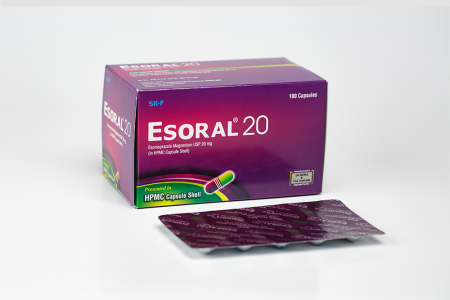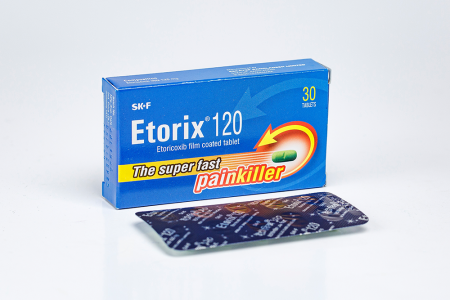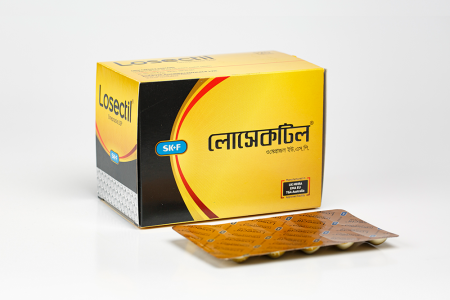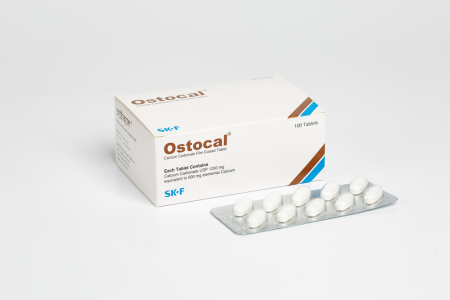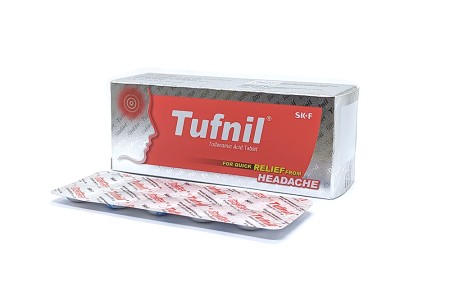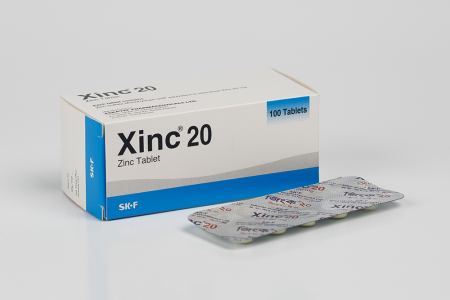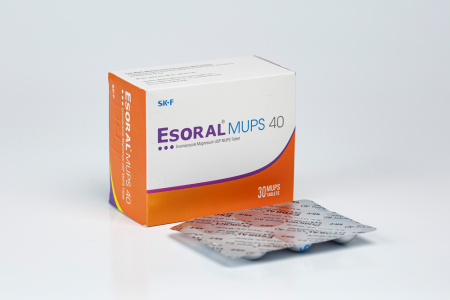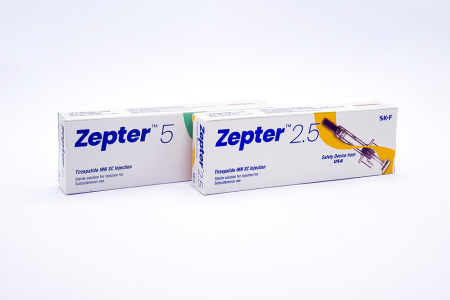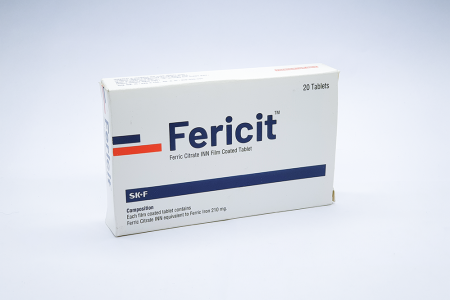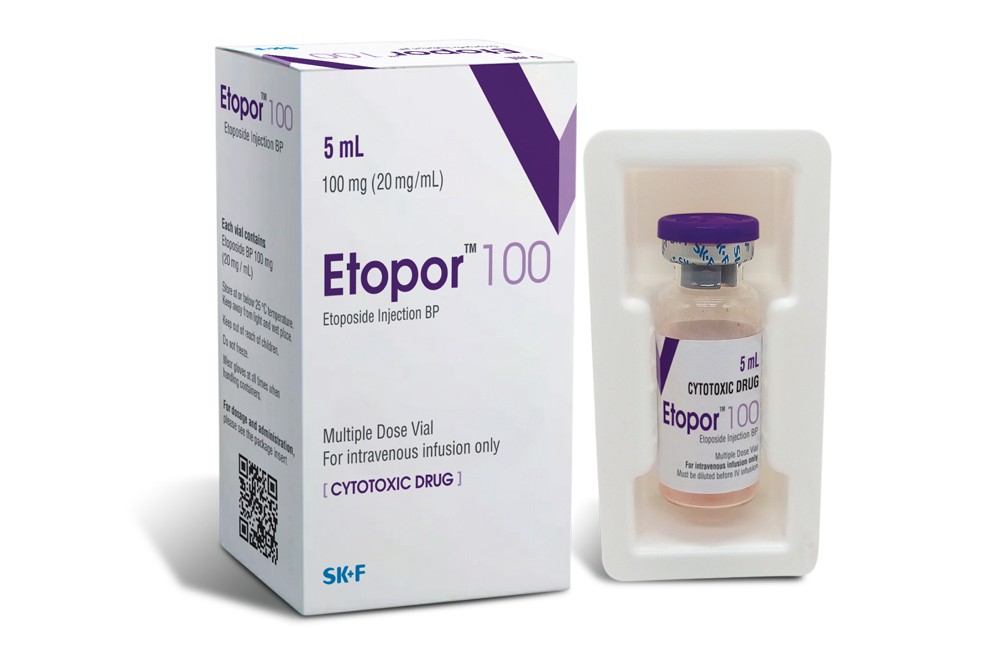

Indications
Etopor is indicated in the management of Small Cell Lung Cancer: Etopor is indicated in combination with other approved chemotherapeutic agents as first-line treatment in patients with small cell lung cancer.
Pharmacology
Pharmacodynamics: Pharmacotherapeutic classification: podophyllotoxin derivatives. Etoposide is a semisynthetic derivative of podophyllotoxin used in the treatment of certain neoplastic diseases. Podophyllotoxins inhibit mitosis by blocking microtubular assembly. Etoposide inhibits cell cycle progression at a premitotic phase (late S and G2). It does not interfere with the synthesis of nucleic acids.
Pharmacokinetics: On intravenous administration, the disposition of etoposide is best described as a biphasic process with a distribution half-life of about 1.5 hours and terminal elimination half-life ranging from 4 to 11 hours. Total body clearance values range from 33 to 48 ml/min or 16 to 36 ml/min/m 2 and, like the terminal elimination half-life, are independent of dose over a range 100-600 mg/m2. Over the same dose range, the areas under the plasma concentration vs time curves (AUC) and the maximum plasma concentration (Cmax) values increase linearly with dose. Etoposide does not accumulate in the plasma following daily administration of 100 mg/m 2 for 4 to 5 days.The mean volumes of distribution at steady state fall in the range of 18 to 29 liters or 7 to 17 L/m2
Dosage & Administration
Small cell lung cancer: The dose in combination with other approved chemotherapeutic drugs ranges from 35 mg/m2/day for 4 days to 50 mg/m2/day for 5 days. Or, as directed by the registered physicians.
In patients with impaired renal function: The initial dose modification should be considered based on measured creatinine clearance: >50 mL/min: 100% of dose; 15-50 mL/min: 75% of dose. Subsequent Etoposide dosing should be based on patient tolerance and clinical effect. Data are not available in patients with creatinine clearances <15 ml/min and further dose reduction should be considered in these patients.
* চিকিৎসকের পরামর্শ মোতাবেক ঔষধ সেবন করুন'
Interaction
High-dose cyclosporine a resulting in concentrations above 2000 ng/ml administered with oral Etopor has led to an 80% increase in Etopor exposure with a 38% decrease in total body clearance of Etopor compared to Etopor alone.
Laboratory Tests: Periodic complete blood counts should be done during the course of Etopor treatment. They should be performed prior to each cycle of therapy and at appropriate intervals during and after therapy. At least one determination should be done prior to each dose of Etopor.
Contraindications
Etoposide is contraindicated in patients who have demonstrated a previous hypersensitivity to Etoposide or any component of the formulation.
Side Effects
The following data on adverse reactions are based on both oral and intravenous administration of Etopor as a single agent, using several different dose schedules for treatment of a wide variety of malignancies.
Hematologic Toxicity: Myelosuppression is dose related and dose limiting, with granulocyte nadirs occurring 7 to 14 days after drug administration and platelet nadirs occurring 9 to 16 days after drug administration. Bone marrow recovery is usually complete by day 20, and no cumulative toxicity has been reported. Fever and infection have also been reported in patients with neutropenia. Death associated with myelosuppression has been reported. The occurrence of acute leukemia with or without a preleukemic phase has been reported rarely in patients treated with Etopor in association with other antineoplastic agents.
Gastrointestinal Toxicity: Nausea and vomiting are the major gastrointestinal toxicities. The severity of such nausea and vomiting is generally mild to moderate with treatment discontinuation required in 1% of patients. Nausea and vomiting can usually be controlled with standard antiemetic therapy. Mild to severe mucositis/ esophagitis may occur. Gastrointestinal toxicities are slightly more frequent after oral administration than after intravenous infusion.
Hypotension: Transient hypotension following rapid intravenous administration has been reported in 1% to 2% of patients. It has not been associated with cardiac toxicity or electrocardiographic changes. No delayed hypotension has been noted. To prevent this rare occurrence, it is recommended that Etopor be administered by slow intravenous infusion over a 30- to 60-minute period. If hypotension occurs, it usually responds to cessation of the infusion and administration of fluids or other supportive therapy as appropriate. When restarting the infusion, a slower administration rate should be used.
Allergic Reactions: Anaphylactic-like reactions characterized by chills, fever, tachycardia, bronchospasm, dyspnea, and/or hypotension have been reported to occur in 0.7% to 2% of patients receiving intravenous Etopor and in less than 1% of the patients treated with the oral capsules. These reactions have usually responded promptly to the cessation of the infusion and administration of pressor agents, corticosteroids, antihistamines, or volume expanders as appropriate; however, the reactions can be fatal. Hypertension and/or flushing have also been reported. Blood pressure usually normalizes within a few hours after cessation of the infusion. Anaphylactic like reactions have occurred during the initial infusion of Etopor. Facial/tongue swelling, coughing, diaphoresis, cyanosis, tightness in throat, laryngospasm, back pain, and/or loss of consciousness have sometimes occurred in association with the above reactions. In addition, an apparent hypersensitivity-associated apnea has been reported rarely. Rash, urticaria, and/or pruritus have infrequently been reported at recommended doses. At investigational doses, a generalized pruritic erythematous maculopapular rash, consistent with perivasculitis, has been reported. Alopecia: Reversible alopecia, sometimes progressing to total baldness, was observed in up to 66% of patients.
Other Toxicities: The following adverse reactions have been infrequently reported: abdominal pain, aftertaste, constipation, dysphagia, asthenia, fatigue, malaise, somnolence, transient cortical blindness,optic neuritis, interstitial pneumonitis/pulmonary fibrosis, fever, seizure (occasionally associated with allergic reactions), Stevens-Johnson syndrome, and toxic epidermal necrolysis, pigmentation, and a single report of radiation recall dermatitis.
Pregnancy & Lactation
Pregnancy category D. There are no adequate and well controlled studies in pregnant woman Etoposide has been reported to be found in human milk. Patient recieves Etoposide should not be breast feed.
Precautions & Warnings
Patients being treated with Etopor must be frequently observed for myelosuppression both during and after therapy. Myelosuppression resulting in death has been reported. Dose limiting bone marrow suppression is the most significant toxicity associated with Etopor therapy. Therefore, the following studies should be obtained at the start of therapy and prior to each subsequent cycle of Etopor: platelet count, hemoglobin, white blood cell count, and differential. The occurrence of a platelet count below 50,000/mm3 or an absolute neutrophil count below 500/mm3 is an indication to withhold further therapy until the blood counts have sufficiently recovered. Physicians should be aware of the possible occurrence of an anaphylactic reaction manifested by chills, fever, tachycardia, bronchospasm, dyspnea, and hypotension. Higher rates of anaphylactic- like reactions have been reported in children who received infusions at concentrations higher than those recommended. The role that concentration of infusion (or rate of infusion) plays in the development of anaphylactic-like reactions is uncertain. Treatment is symptomatic. The infusion should be terminated immediately, followed by the administration of presser agents, corticosteroids, antihistamines, or volume expanders at the discretion of the physician. For parenteral administration, Etopor should be given only by slow intravenous infusion (usually over a 30 to 60 minute period) since hypotension has been reported as a possible side effect of rapid intravenous injection In all instances where the use of Etopor is considered for chemotherapy, the physician must evaluate the need and usefulness of the drug against the risk of adverse reactions. Most such adverse reactions are reversible if detected early. If severe reactions occur, the drug should be reduced in dosage or discontinued and appropriate corrective measures should be taken according to the clinical judgment of the physician. Reinstitution of Etopor therapy should be carried out with caution, and with adequate consideration of the further need for the drug and alertness as to possible recurrence of toxicity. Patients with low serum albumin may be at an increased risk for Etopor associated toxicities.
Therapeutic Class
Cytotoxic Chemotherapy
Storage Conditions
Must be stored under refrigeration 2°-8°C. The capsules are stable for 24 months under such refrigeration conditions. Keep all medicines out of reach of children. Protect from light. Procedure for proper handling and disposal of anticancer drugs should be considered.



